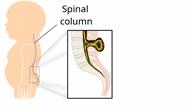When You're Born With Part of the Spine in a Pocket Outside the Body (Myelomeningocele): What to Know

Myelomeningocele is a birth defect in which the spinal nerves, fluid, and cord stick out of the back at birth, forming a sac on the baby's back. It is a type of spina bifida. Spina bifida is a condition in which the spinal column and vertebrae are not formed correctly in the womb.
What are the causes?
The exact cause of this condition is not known.
When the spinal cord is forming, it normally starts out shaped like an open tube. This tube slowly closes from top to bottom. Myelomeningocele happens when this tube does not close completely.
What increases the risk?
This condition is more likely to develop in:- Children whose mothers did not get enough folic acid during pregnancy.
- Children who have siblings with myelomeningocele.
- Children whose mothers were taking certain medicines, such as valproic acid.
What are the signs or symptoms?
Children with this condition have a fluid-filled sac that sticks out of the back at birth. Other symptoms depend on where in the back the problem exists. They may include:- Loss of bladder or bowel control. This can cause urine or stool to leak. Sometimes the child has difficulty passing stool (constipation).
- Lack of feeling in the area of the body below the fluid-filled sac.
- Partial or complete inability to move the legs (paralysis). This can cause problems in growth and development, including inability to crawl or walk.
- Joint problems. This is most noticeable in the hips, knees, and feet. Joint issues can cause deformities or problems with normal function of the joints.
How is this diagnosed?
This condition can be diagnosed before birth. Blood tests and an ultrasound of the fetus are usually done to confirm the diagnosis.
How is this treated?
There is no cure for myelomeningocele, but there are many treatments available for the problems it causes. Usually, a team of health care providers is needed to address these problems. Treatments include:- Surgery to close the opening of the spinal cord in order to prevent infections from developing. This is often the first treatment to be done.
- Corrective surgery and bracing for leg problems.
- Medicines, surgery, and the placement of a tube in the bladder to help empty urine (bladder catheterization).
- Putting fluid into the rectum (enema) to help with constipation and stool leakage. Medicines and diet can also be used to treat this problem.
- Surgery to place a tube called a ventriculoperitoneal (VP) shunt from the brain to the abdomen. This is sometimes needed because the condition can be associated with having too much fluid in the brain (hydrocephalus) or a brain abnormality called Chiari malformation. The tube prevents fluid and pressure from building up in the skull due to a lack of normal drainage of spinal fluid.
A team of health care providers and specialists will monitor your child's health and growth over time.
Follow these instructions at home:
-
Follow all instructions as given by your child's health care providers. These may include instructions for treating your child for problems in the bladder, the bowels, and the bones and joints.
-
Pay careful attention to water temperature when bathing your child. Watch your child around other heat sources. This is important because your child may not react to high heat if he or she loses feeling in the legs or buttocks.
-
Take good care of your child's skin. Watch for redness or sores.
-
Give your child over-the-counter and prescription medicines only as told by the health care provider.
-
Look to friends and family for support if needed. Support groups and counseling are useful in helping you work through any stress that arises from caring for your child.
-
Keep all follow-up visits. This is important. Your child will need regular kidney and bladder testing.
Where to find more information
Spina Bifida Association: www.spinabifidaassociation.org
Contact a health care provider if:
-
Your child is having more difficulty with urination or bowel movements.
-
Your child has new leg weakness or numbness.
-
Your child develops new headaches.
Get help right away if:
- Your child shows signs of increased pressure buildup at the base of the brain. These signs include:
- Squeaky, labored inhaling.
- Choking on food.
- Hoarseness or lack of a voice.
- Shallow breathing or periods when breathing stops.
-
Your child does not have a history of seizures and experiences a seizure of any length of time.
-
Your child has a VP shunt and experiences a seizure of any length, develops headaches, or has vision loss.
These symptoms may represent a serious problem that is an emergency. Do not wait to see if the symptoms will go away. Get medical help right away. Call your local emergency services (911 in the U.S.).
Summary
-
Myelomeningocele is a birth defect caused by incomplete closure of the child's spinal column when it is forming in the womb.
-
Children with this condition have a fluid-filled sac that sticks out of the back at birth.
-
There is no cure for myelomeningocele, but there are many treatments available for the problems it causes.
-
A team of health care providers and specialists will monitor your child's health and growth over time.
This information is not intended to replace advice given to you by your health care provider. Make sure you discuss any questions you have with your health care provider.

